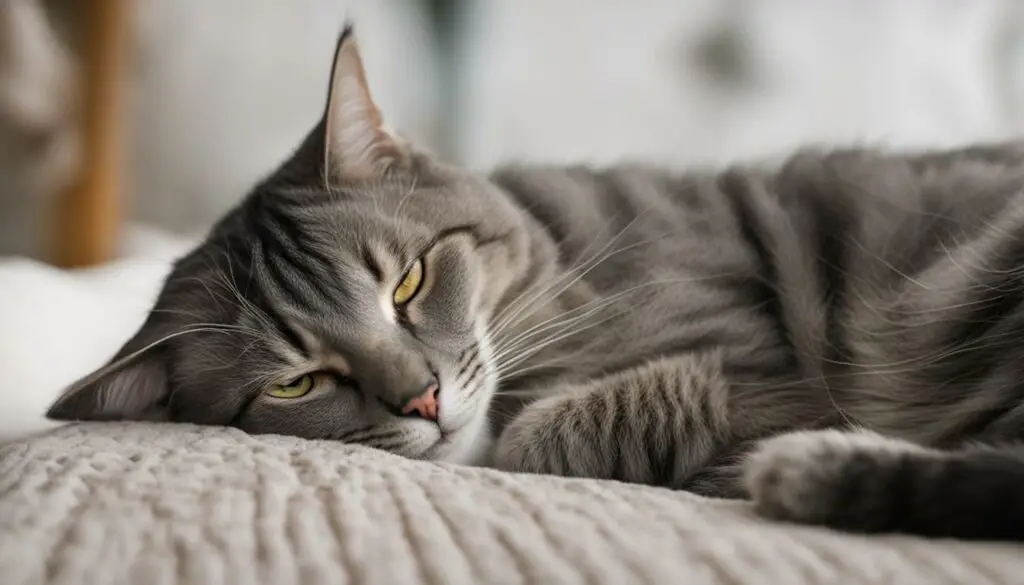After spaying surgeries, it is normal for cats to feel tired and require rest. The effects of the anesthesia may cause cats to be either hyperactive or lethargic immediately after the surgery, but these behaviors usually subside once the drugs wear off. Cats may appear less affectionate after being spayed, as the surgery eliminates the hormonal changes associated with being in heat. If a cat continues to be lethargic after a few days, it is advisable to consult with a veterinarian to ensure there are no underlying issues.
Key Takeaways:
- It is normal for cats to be lethargic after spaying surgery.
- The effects of anesthesia may cause temporary lethargy or hyperactivity.
- Cats may appear less affectionate after being spayed due to hormonal changes.
- If lethargy persists beyond a few days, consult a veterinarian.
- Proper aftercare and rest are crucial for a smooth recovery.
Do Cats Get Depressed After Being Spayed?
After a cat undergoes spaying surgery, it is common for their behavior to change. However, it is important to note that these changes are not indicative of depression. Cats may appear more distant and less affectionate after being spayed, but this is a result of the surgery itself, not a reflection of their emotional state. The removal of the reproductive organs eliminates the hormonal changes that can influence a cat’s behavior, such as demanding attention or displaying physical reciprocation.
While it is understandable for pet owners to be concerned about their cat’s well-being, it is essential to differentiate between normal post-surgery behavior and depression. Cats’ recovery after being spayed generally takes around 10 to 14 days, during which they may exhibit signs of tiredness and reduced activity. It is crucial to provide a calm and comforting environment for their healing process, ensuring they receive proper rest and care.
During the recovery period, it is advisable to monitor the cat closely for any signs of complications or prolonged lethargy. If the cat shows persistent signs of depression or if their behavior deviates significantly from their usual personality, it is recommended to consult with a veterinarian for further assessment and guidance.
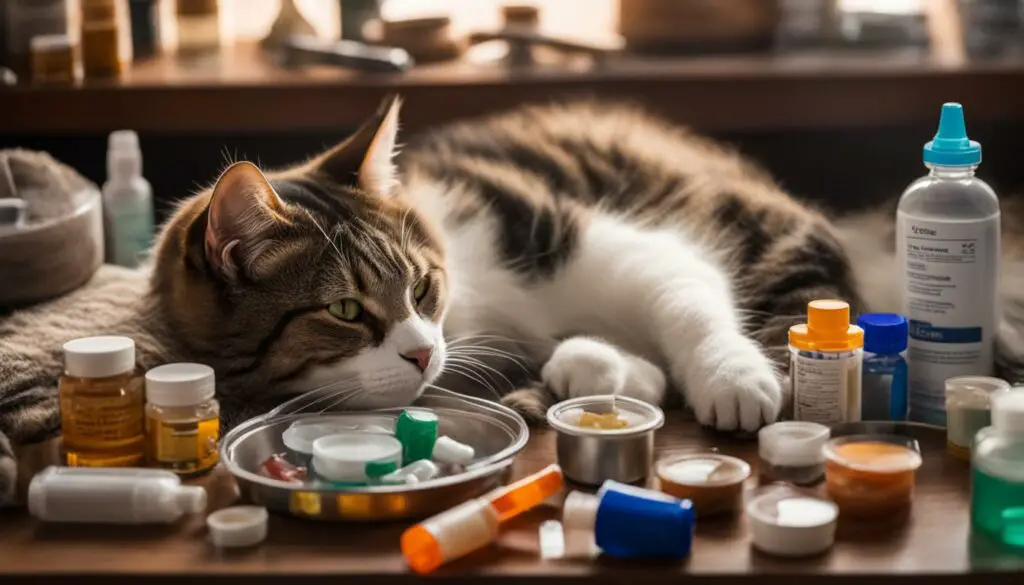
Table: Common Behavior Changes After Spaying Surgery
| Behavior Changes | Explanation |
|---|---|
| Lethargy and tiredness | Normal response to surgery and anesthesia |
| Reduced affection | Elimination of hormonal changes associated with being in heat |
| Decreased activity level | Natural recovery process that requires rest |
| Increased sensitivity at the surgical site | Pain and discomfort from the incision |
Table: Common Behavior Changes After Spaying Surgery
Is It Normal For Cats To Be Lethargic After Spay?
After spaying surgery, it is normal for cats to experience lethargy and tiredness. The anesthesia used during the surgery can have lingering effects, making the cat appear sleepy and less active immediately after the procedure. However, as the anesthesia wears off, the cat may start to feel discomfort and soreness from the incision site, which can contribute to their lethargy.
It is crucial to monitor the surgical site for any signs of infection and ensure that the cat gets enough rest during this recovery period. While it is expected for a cat to be less active and show reduced appetite for a few days following the surgery, if the lethargy persists beyond the expected recovery time, it is advisable to consult with a veterinarian to rule out any potential complications or underlying issues.
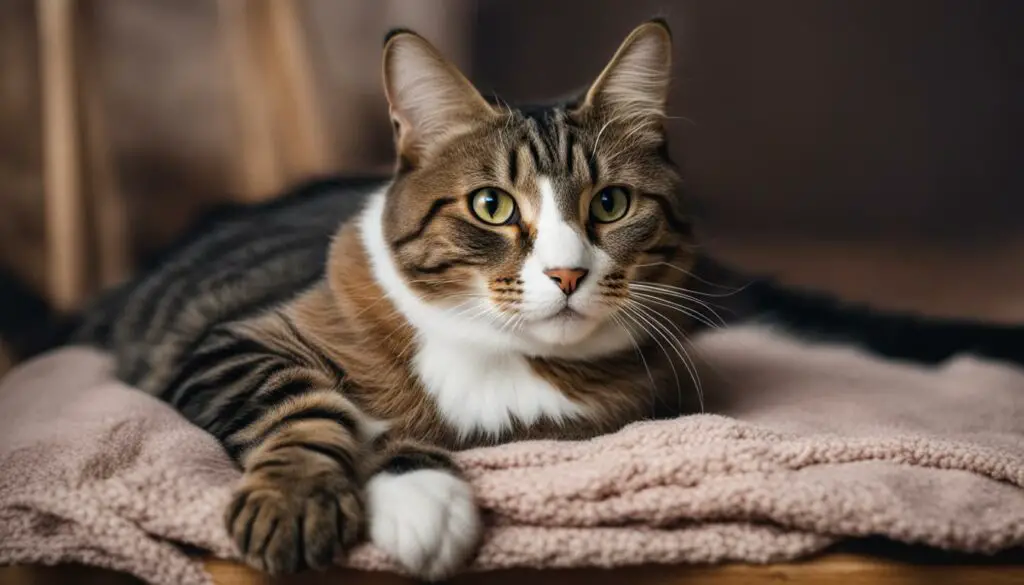
Factors that can influence cat’s recovery time
The recovery time after a spay surgery can vary depending on various factors such as the cat’s age, overall health, and individual healing ability. Younger cats tend to recover faster than older cats. Additionally, cats with existing health issues or weakened immune systems may have a longer recovery period.
It is essential for pet owners to provide appropriate aftercare during this time, ensuring that the cat receives proper nutrition, hydration, and a calm environment for rest. Adhering to postoperative guidelines and closely monitoring the cat’s behavior and the surgical site can help promote a smooth recovery and minimize the risk of complications.
| Factors | Influence on Recovery Time |
|---|---|
| Age | Younger cats often recover faster than older cats |
| Overall Health | Cats with existing health issues may have a longer recovery period |
| Individual Healing Ability | Some cats naturally heal faster than others |
By providing the necessary care, monitoring, and attention, pet owners can help their cats have a smooth recovery and ensure their overall well-being after spaying surgery.
Cat Lethargic 3 Days After Spay: Is It Normal?
After a cat undergoes a spaying surgery, it is not uncommon to notice lethargy and decreased energy levels. This is a normal part of the recovery process and can last for several days. The body needs time to heal and adjust after the procedure, and rest is essential for this process. It is important to provide a calm and comfortable environment for your cat and avoid any strenuous activities during this time.
In addition to lethargy, some cats may also experience a decrease in appetite after being spayed. This can be due to a combination of factors, including the effects of anesthesia, pain or discomfort from the surgery, and changes in hormone levels. It is important to monitor your cat’s eating habits and ensure they are getting adequate nutrition during their recovery. If your cat is not eating or showing other concerning symptoms, it is best to consult with a veterinarian for further guidance.
While it can be worrying to see your cat being lethargic after spaying, it is important to remember that every cat’s recovery process is different. If you have any concerns or notice any unusual behavior, it is always best to reach out to your veterinarian for professional advice. They can provide guidance specific to your cat’s individual needs and ensure a smooth recovery.
| Common Symptoms After Cat Spaying | Duration |
|---|---|
| Lethargy and decreased energy levels | Up to a week |
| Decreased appetite | Up to a week |
| Swelling or redness at the surgical site | A few days to a week |
| Mild discomfort or pain | A few days to a week |
| Changes in behavior or temperament | Variable |
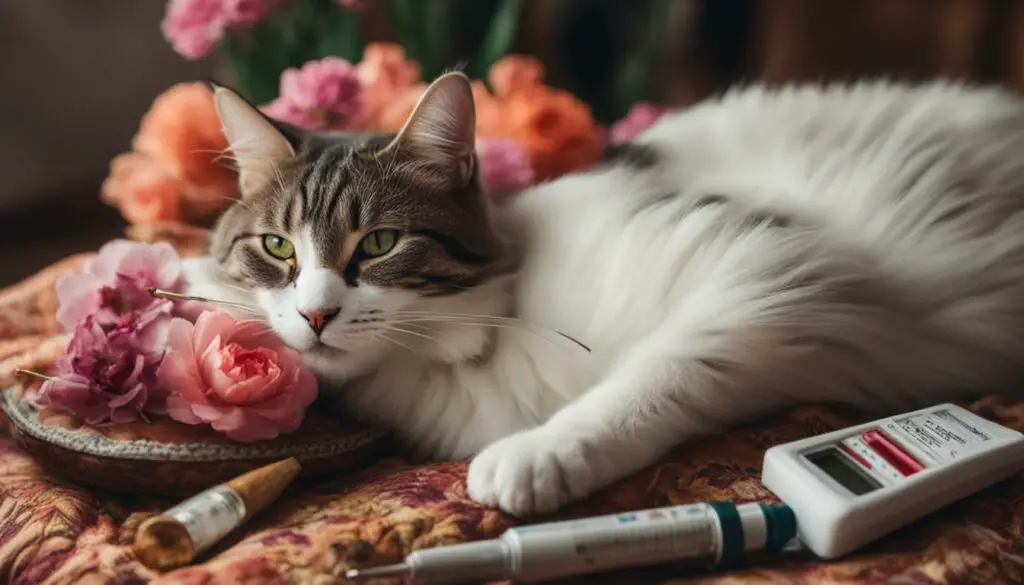
“After a cat undergoes a spaying surgery, it is not uncommon to notice lethargy and decreased energy levels. This is a normal part of the recovery process and can last for several days.”
Importance of Rest and Monitoring
During this recovery period, it is crucial to prioritize rest for your cat. Provide a quiet and comfortable space where they can relax and sleep without disturbance. Limit their activity and avoid any rough play or jumping on furniture. Regularly monitor the incision site for any signs of infection, such as excessive redness, swelling, or discharge. If you notice any concerning symptoms or the lethargy persists beyond a week, it is recommended to consult with your veterinarian for a thorough examination.
- Ensure a calm and comfortable environment for your cat’s recovery.
- Monitor your cat’s eating habits and provide appropriate nutrition.
- Limit activity and avoid strenuous exercise.
- Regularly check the incision site for any signs of infection.
- Contact your veterinarian if there are any concerns or unusual behavior.
How Long Will My Cat Be Lethargic For After The Surgery?
After spaying surgery, it is common for cats to experience lethargy as part of their recovery process. Understanding how long this lethargy may last can help pet owners provide the necessary care and support for their cats during this time.
In general, cats may exhibit lethargy for approximately 10 to 14 days after spaying surgery. However, it’s important to note that the recovery period can vary for each individual cat. Some cats may bounce back quicker and show signs of energy sooner, while others may take a bit longer to fully recover.
During this period of lethargy, it’s crucial to create a calm and quiet environment for your cat. Offer them a comfortable and cozy space where they can rest undisturbed. Monitor their behavior and ensure they are eating, drinking, and using the litter box normally. If you notice any concerning symptoms or if the lethargy persists beyond the expected recovery period, it’s best to consult with a veterinarian for further evaluation.
| Signs of Normal Recovery | Signs That Require Veterinary Attention |
|---|---|
|
|
By monitoring your cat’s recovery closely and seeking veterinary guidance when necessary, you can ensure that they have a smooth and healthy healing process after their spaying surgery.
Section 6: How Long Does It Take A Female Cat To Recover After Spay?
After undergoing a spaying surgery, it is natural for a female cat to require a recovery period. The length of time it takes for a cat to fully recover can vary, but on average, it takes around 10 to 15 days. During this recovery period, it is important to provide the cat with the necessary care and attention to ensure a smooth healing process.
One of the key aspects of post-spay recovery is to ensure that the cat gets enough rest. Keeping the cat in a quiet and comfortable environment can help minimize stress and aid in the healing process. It is also essential to monitor the surgical site for any signs of infection or inflammation. If any concerns arise, it is advisable to consult with a veterinarian.
Additionally, during the recovery period, it is important to provide the cat with proper nutrition and hydration. Ensuring that the cat is eating and drinking well can help support their overall recovery. It is not uncommon for cats to have a decreased appetite immediately after surgery, but if the cat continues to not eat after a few days, it is recommended to seek veterinary advice.
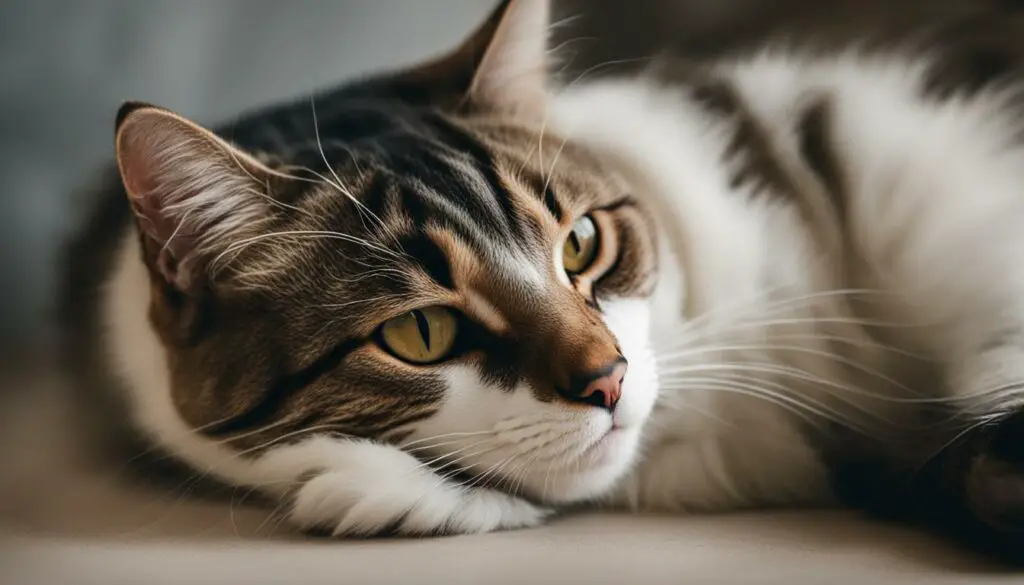
Table:
| Recovery Period: | 10 to 15 days |
|---|---|
| Key Aspects: | Rest, monitoring the surgical site, proper nutrition and hydration |
| Signs of Concern: | Infection, inflammation, lack of appetite |
What to Expect Immediately After the Spay?
After a cat undergoes spaying surgery, it is normal for them to experience grogginess and fatigue due to the lingering effects of anesthesia. Some cats may also exhibit disorientation or reduced responsiveness. It is important to provide a calm and comfortable environment for the cat to recover and closely monitor their behavior for any signs of complications or distress.
During this initial recovery period, it is crucial to limit the cat’s physical activity and provide them with a quiet space where they can rest undisturbed. This will allow their body to heal and recover from the surgery. It is also recommended to closely monitor the incision site for any signs of infection, such as redness, swelling, or discharge. If any abnormalities are noticed, it is important to contact a veterinarian for further guidance.
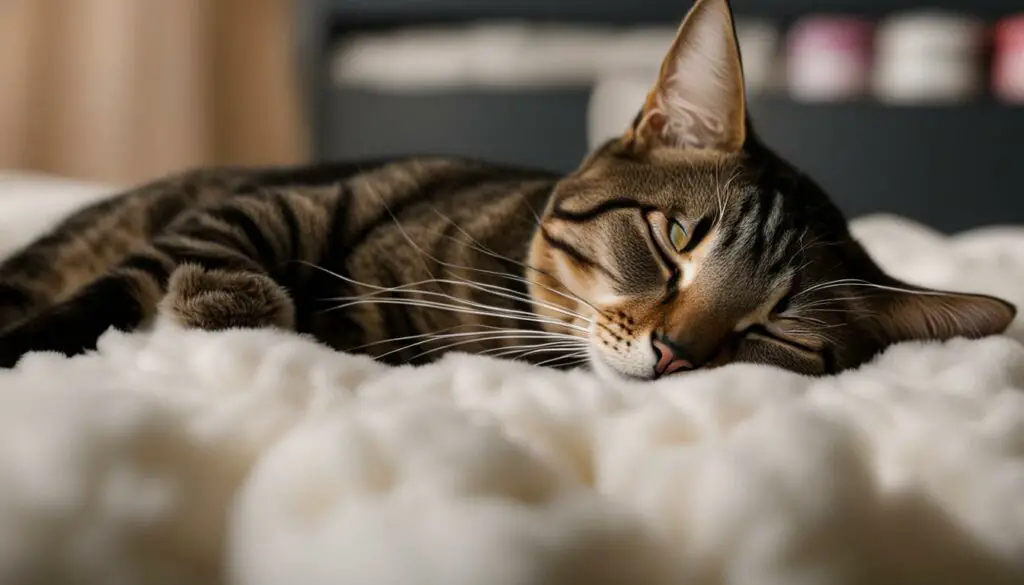
In addition to physical symptoms, some cats may experience temporary behavioral changes immediately after the spaying surgery. They may appear more subdued or less interested in social interactions. This is normal and, in most cases, these changes will gradually resolve as the cat’s body adjusts to the absence of reproductive hormones.
It is important to remember that each cat’s recovery process may vary, and it is essential to provide individualized care and attention based on their specific needs. By closely monitoring their behavior and providing a supportive environment, you can help ensure a smooth and successful recovery for your cat after spaying surgery.
Aftercare for Cat Spaying
Proper aftercare is crucial for ensuring a smooth recovery after a cat’s spaying surgery. By following these guidelines, you can help your feline friend heal properly and minimize the risk of complications.
Rest and Limit Activity
One of the most important aspects of aftercare is to provide your cat with sufficient rest and limit their physical activity. This allows their body to heal and reduces the risk of reopening the spay incision or experiencing post-surgery complications. Create a calm and comfortable environment for your cat and ensure they have a quiet space to rest and recover.
Monitor the Surgical Site
Regularly examine the surgical site for any signs of infection or inflammation. Look for redness, swelling, discharge, or excessive licking or scratching. If you notice any abnormalities, contact your veterinarian for further guidance. It can also be helpful to use an Elizabethan collar or other suitable methods to prevent your cat from bothering the incision.
Follow Veterinary Recommendations
Your veterinarian will provide you with specific postoperative instructions for your cat’s aftercare. It is crucial to follow these recommendations closely to promote optimal healing. This may include providing pain medication or antibiotics as prescribed, administering any necessary wound care, and scheduling follow-up appointments to monitor your cat’s progress.
| Aftercare Measures | Benefits |
|---|---|
| Rest and Limit Activity | Allows the body to heal and reduces the risk of complications |
| Monitor the Surgical Site | Early detection of any infection or inflammation can prevent further complications |
| Follow Veterinary Recommendations | Ensures proper medication administration and monitoring of the cat’s progress |
By providing attentive aftercare, you can help your cat recover smoothly after spaying surgery. Remember to consult your veterinarian if you have any concerns or questions during the recovery process.
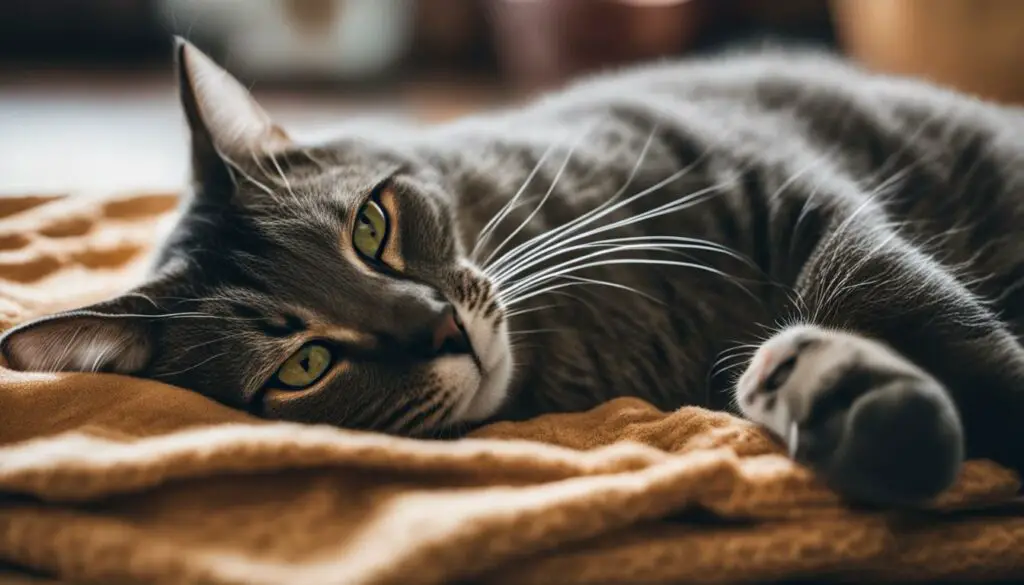
How to Keep the Spay Incision from Opening or Getting Infected?
After a cat has undergone spaying surgery, it is essential to take precautions to prevent the incision from opening or becoming infected. Here are some important measures you can take to ensure the proper healing of the surgical site:
- Prevent licking or scratching: Cats may instinctively try to lick or scratch the incision site, which can delay healing or introduce infection. To prevent this, it is recommended to use an Elizabethan collar or an alternative method suggested by your veterinarian to restrict access to the surgical area.
- Monitor the incision: Regularly check the spay incision for any signs of redness, swelling, discharge, or abnormal odor. If you notice any of these symptoms or if the incision starts to open, it is crucial to consult with your veterinarian immediately.
- Avoid excessive activities: Excessive activity can put strain on the incision and hinder the healing process. It is important to keep your cat calm and restrict their physical activity during the recovery period.
Following these measures will greatly reduce the risk of complications and promote proper healing of the spay incision. Remember to consult with your veterinarian if you have any concerns or notice any unusual changes in your cat’s behavior or the surgical site.
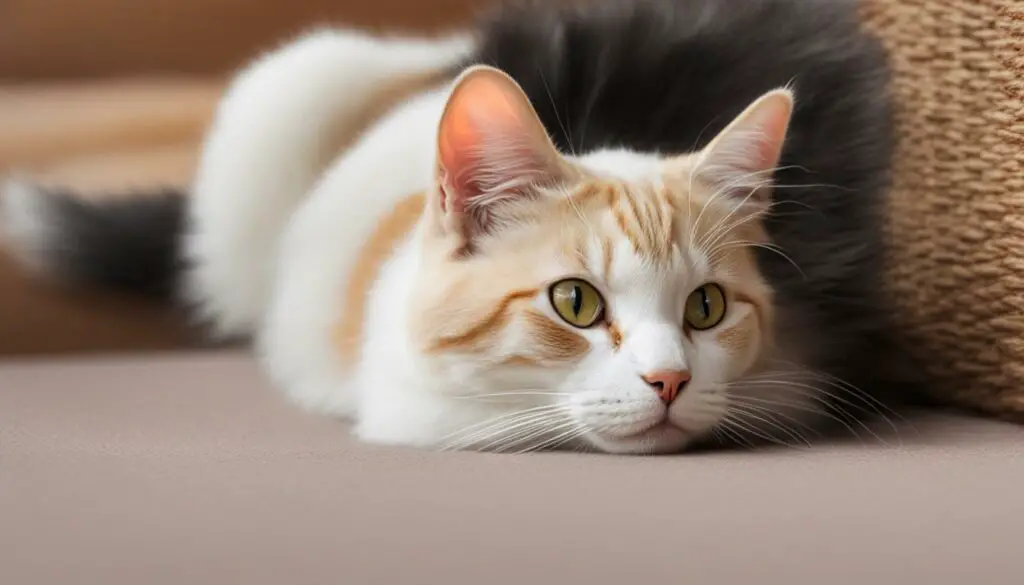
Preventing infection and promoting healing
| Measures to Take | Benefits |
|---|---|
| Using Elizabethan collar or alternative methods to prevent licking or scratching | Minimizes the risk of infection and opens incision |
| Regularly monitoring the incision site for any signs of infection, redness, or discharge | Allows early detection of complications |
| Restricting physical activity to prevent strain on the incision | Promotes proper healing and reduces the risk of the incision opening |
Bathing and Swimming Restrictions After Spaying
After your cat has undergone spaying surgery, it is important to be mindful of bathing and swimming restrictions during the recovery period. The incision site needs time to heal properly, and exposing it to water can increase the risk of infection or delay the healing process. It is generally advised to refrain from bathing or allowing your cat to swim until the spay incision has fully healed and the veterinarian has given clearance.
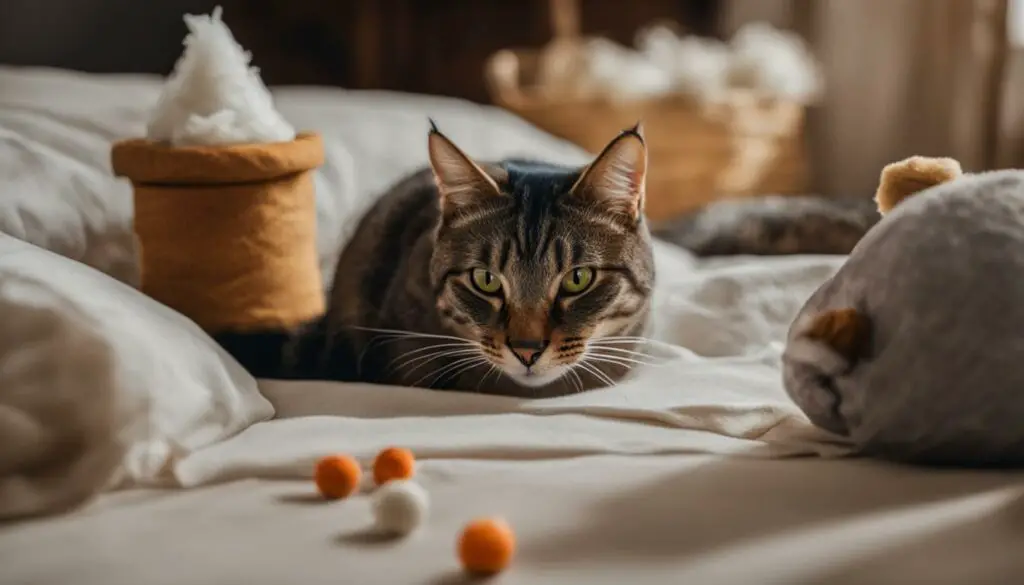
The recovery period for a cat after spaying surgery typically spans around 10 to 14 days, but this duration may vary based on individual healing processes. It is crucial to follow the veterinarian’s instructions and recommendations regarding post-spay bathing and swimming to ensure the best possible outcome for your cat.
While it may be tempting to bathe your cat to keep them clean or allow them to swim for exercise, it is essential to prioritize their well-being and allow for proper recovery. During this period, it is important to keep the incision site dry and clean to prevent any potential complications from arising.
In summary, it is generally advised to avoid bathing and swimming for a period of approximately 10 to 14 days after spaying surgery. By following the veterinarian’s guidance, you can ensure that your cat has a smooth recovery and reduces the risk of any complications.
Cat Spay and Neuter Aftercare
After a cat has been spayed, certain aftercare practices should be followed to promote proper healing and prevent complications. These practices include restricting the cat’s activity, preventing licking or scratching of the surgical site, monitoring the incision for any signs of infection, and following any postoperative guidelines provided by the veterinarian.
Restricting the cat’s activity is crucial in allowing the surgical site to heal properly. It is important to minimize jumping, running, and rough play during the recovery period. This can be achieved by confining the cat to a quiet room or using a recovery crate or cage. Providing a comfortable and stress-free environment will aid in the cat’s recovery process.
To prevent infection, it is essential to prevent the cat from licking or scratching the surgical site. This can be done by using an Elizabethan collar or other suitable methods recommended by the veterinarian. Keeping the incision clean and dry is crucial, and any unusual discharge or redness should be promptly reported to the veterinarian.
“Proper aftercare is crucial for the cat’s well-being and a successful recovery from spaying surgery.”
Cat Spay and Neuter Aftercare Tips:
- Restrict the cat’s activity to promote healing.
- Prevent licking or scratching of the surgical site by using an Elizabethan collar or other suitable methods.
- Monitor the incision for any signs of infection, such as redness or discharge.
- Follow any postoperative guidelines and recommendations provided by the veterinarian.
By following these aftercare practices, pet owners can help ensure their cats have a smooth and successful recovery from spaying surgery. It is important to stay in close communication with the veterinarian and seek their guidance if any concerns or complications arise during the recovery process. With proper care and attention, cats can enjoy a healthier and happier life after being spayed.
| Aftercare Practices | Benefits |
|---|---|
| Restricting the cat’s activity | Promotes proper healing |
| Preventing licking or scratching of the surgical site | Reduces the risk of infection |
| Monitoring the incision for signs of infection | Allows for early detection and prompt treatment |
| Following postoperative guidelines | Ensures optimal recovery and minimizes complications |
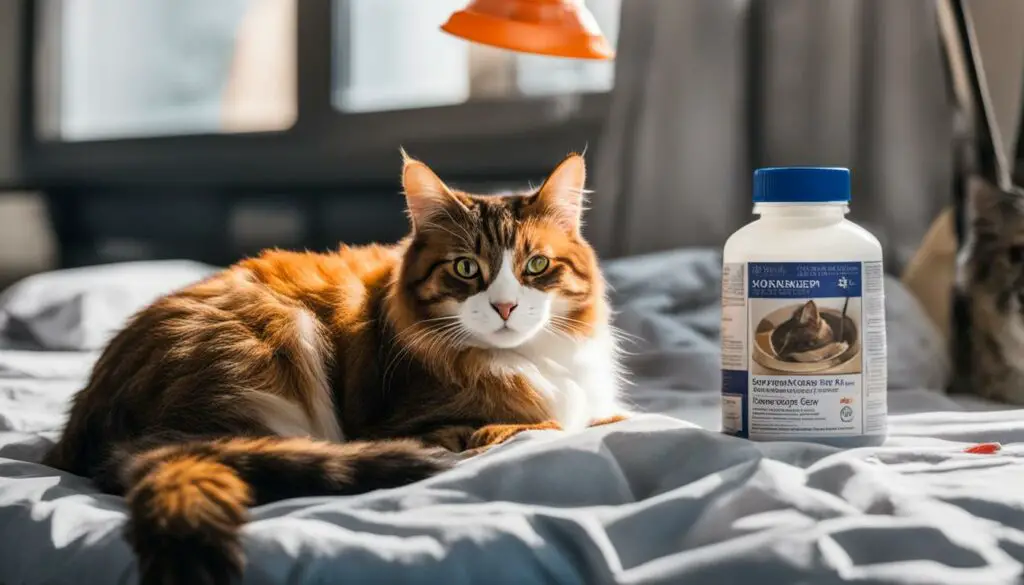
Cat Spay and Neuter Aftercare
Proper aftercare following a cat’s spay or neuter surgery is crucial for promoting a smooth recovery and minimizing any potential side effects. It is important to provide the necessary care and attention to ensure your cat’s well-being during this postoperative period. Some key aftercare measures to consider include:
Restricting Activity
Following the surgery, it is essential to limit your cat’s physical activity to prevent any strain on the surgical site. Avoid allowing your cat to jump on furniture or engage in vigorous play for at least 10 to 14 days, or as advised by your veterinarian. Rest is crucial for proper healing.
Monitoring the Surgical Site
Regularly examine the incision site for any signs of infection, such as redness, swelling, or discharge. If you notice any abnormalities, contact your veterinarian immediately for further guidance. Keep the incision clean and dry, and avoid applying any lotions or ointments unless specifically prescribed by your veterinarian.
Using an Elizabethan Collar
To prevent your cat from licking or chewing the surgical site, your veterinarian may recommend using an Elizabethan collar. This collar helps to ensure that your cat cannot interfere with the healing process, reducing the risk of infection or further complications.
By following these aftercare measures and closely monitoring your cat’s recovery, you can help ensure a smooth and successful healing process after their spay or neuter surgery.
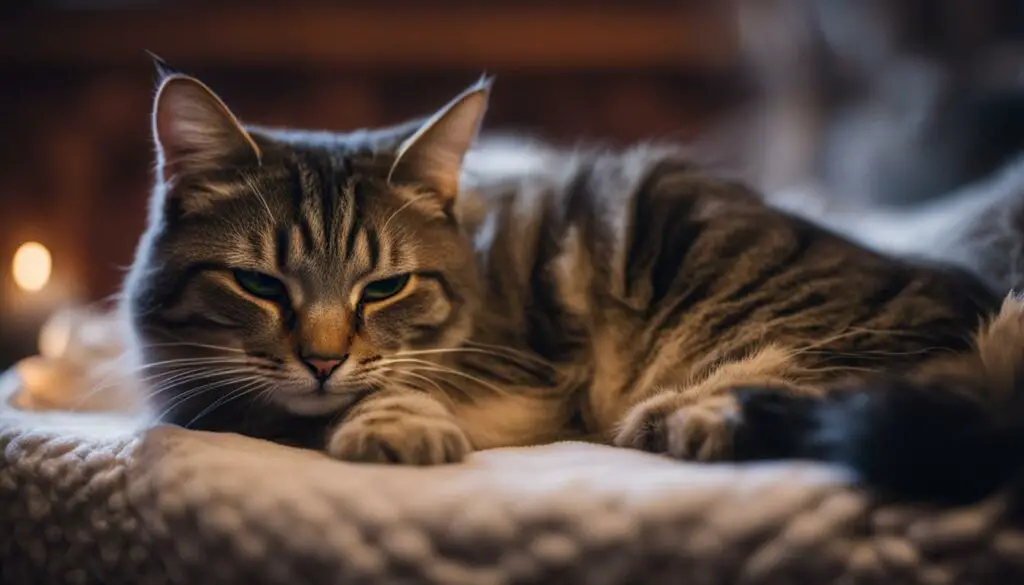
Cat Spay and Neuter Aftercare
Proper aftercare following a cat’s spay or neuter surgery is essential for promoting a smooth recovery. During this time, it is important to restrict the cat’s activity, prevent licking or chewing of the surgical site, and monitor the incision for any signs of infection or complications. Providing proper nutrition and hydration is also crucial for supporting the healing process. Following the veterinarian’s instructions and scheduling any necessary follow-up appointments is an important aspect of aftercare.
One key aspect of cat spay and neuter aftercare is ensuring that the cat gets adequate rest. This involves providing a quiet and comfortable environment where the cat can recover without being disturbed. Rest is vital for allowing the body to heal and reducing the risk of complications.
Additionally, it is important to prevent the cat from licking or chewing the surgical site. This can be achieved by using an Elizabethan collar or other suitable methods recommended by the veterinarian. Licking or chewing the incision can lead to infection or the opening of the wound, which can significantly impact the recovery process.
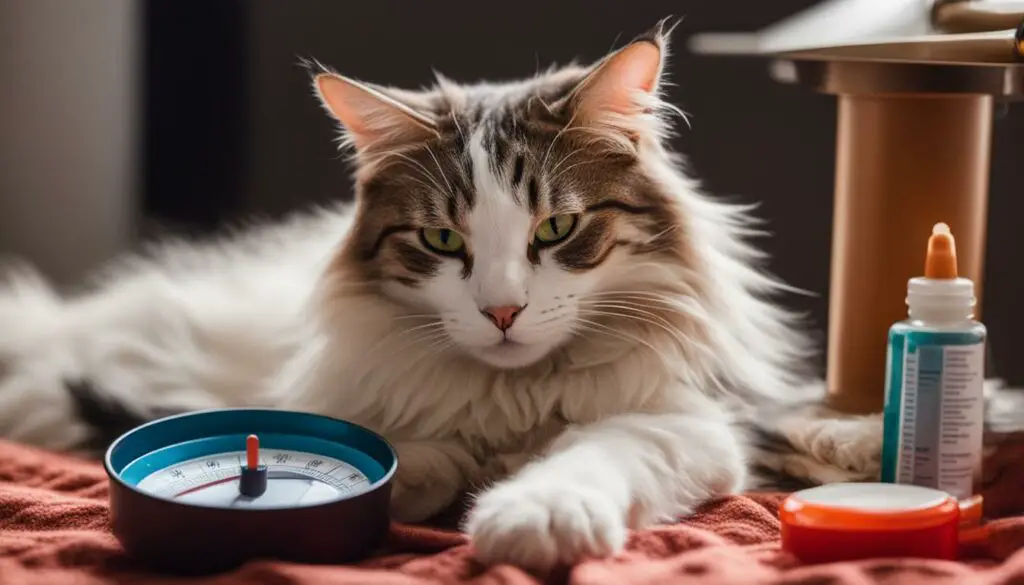
Monitoring the incision is another crucial aspect of cat spay and neuter aftercare. It is important to keep an eye out for any signs of infection, such as redness, swelling, discharge, or a foul odor. If any of these symptoms are observed, it is important to consult with a veterinarian as soon as possible.
| Signs of Infection | Actions to Take |
|---|---|
| Redness or swelling around the incision | Contact the veterinarian for further guidance |
| Discharge or pus coming from the incision | Seek immediate veterinary attention |
| Foul odor from the incision | Consult with a veterinarian for evaluation |
In addition to rest and wound monitoring, providing proper nutrition and hydration is essential for the cat’s recovery. Ensure that the cat has access to fresh water at all times and offer small, frequent meals to prevent any digestive issues. If the cat is not eating after the spay surgery, it is important to consult with a veterinarian as it may indicate a potential problem.
To summarize, aftercare following a cat’s spay or neuter surgery involves restricting activity, preventing licking or chewing of the surgical site, monitoring for signs of infection, and providing proper nutrition and hydration. Following these guidelines and seeking veterinary advice when necessary will help ensure a smooth and successful recovery for your cat.
Cat Spay and Neuter Aftercare
After a cat has undergone spaying or neutering surgery, it is important to provide proper aftercare to ensure a smooth recovery. This includes restricting the cat’s activity, using an Elizabethan collar or other suitable methods to prevent licking or scratching of the surgical site, monitoring for any signs of infection or complications, and following any postoperative guidelines and recommendations provided by the veterinarian.
During the recovery period, it is crucial to limit the cat’s physical activity to prevent strain on the incision site. This means keeping the cat indoors and discouraging jumping or rough play. Additionally, it is essential to prevent the cat from licking or scratching the surgical site, as this can lead to infection or reopen the incision. Using an Elizabethan collar or other preventive measures recommended by the veterinarian can help ensure the cat’s safety and promote proper healing.
Regular monitoring of the incision site is vital to catch any signs of infection or complications early on. Look for redness, swelling, discharge, or any abnormal behavior exhibited by the cat. If any concerning symptoms arise, it is important to consult with the veterinarian promptly. Following the postoperative guidelines provided by the veterinarian, such as administering any prescribed medications or following specific dietary recommendations, is crucial for the cat’s recovery.
By providing diligent and attentive aftercare, pet owners can help their cats recover smoothly after spaying or neutering surgery. Remember to consult with the veterinarian for any specific instructions or concerns, as each cat’s recovery process may vary.
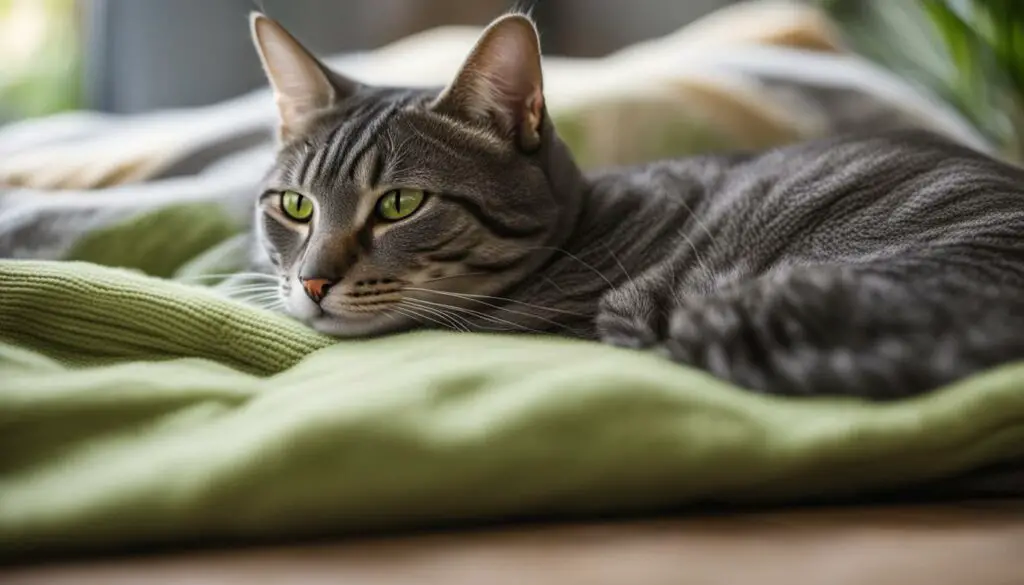
Tips for Cat Spay and Neuter Aftercare:
- Restrict the cat’s activity to prevent strain on the incision site.
- Use an Elizabethan collar or other preventive measures to prevent licking or scratching of the surgical site.
- Monitor the incision site for any signs of infection or complications.
- Follow any postoperative guidelines and recommendations provided by the veterinarian.
- Administer any prescribed medications and follow specific dietary recommendations.
| Activity | Do | Don’t |
|---|---|---|
| Restricting physical activity | Keep the cat indoors and limit jumping or rough play. | Allow excessive physical activity or strenuous play. |
| Preventing licking or scratching | Use an Elizabethan collar or other suitable methods recommended by the veterinarian. | Allow the cat to lick or scratch the surgical site. |
| Monitoring the incision site | Regularly check for signs of infection, such as redness, swelling, or discharge. | Ignore any concerning symptoms or abnormalities. |
| Following postoperative guidelines | Administer prescribed medications and follow any dietary recommendations. | Disregard any instructions provided by the veterinarian. |
Cat Spay and Neuter Aftercare
After a cat’s spaying or neutering surgery, diligent aftercare is crucial for promoting optimal healing and reducing the risk of complications. It is important to limit the cat’s activity and prevent them from licking or chewing the surgical site, as this can lead to infection or delayed healing. Providing proper nutrition and hydration is also essential for the cat’s overall well-being during the recovery period.
Monitoring the incision site is a critical part of aftercare. Regularly check for any signs of infection, such as redness, swelling, discharge, or a foul odor. If you observe any of these symptoms, it is important to consult with a veterinarian promptly. They will be able to provide appropriate treatment and ensure the best possible outcome for your cat’s recovery.
Additionally, following any postoperative care instructions provided by the veterinarian is vital. These instructions may include administering medications, such as pain relievers or antibiotics, as prescribed. It is essential to administer medications as directed and complete the full course of treatment.
Table: Schedule of Postoperative Care
| Postoperative Care | Frequency |
|---|---|
| Monitor incision site | Daily |
| Administer medications | As prescribed by the veterinarian |
| Provide proper nutrition and hydration | Daily |
| Restrict activity and prevent licking or chewing of the surgical site | Throughout the recovery period |
| Follow-up appointments with the veterinarian | As scheduled |
By following these aftercare guidelines, you can ensure that your cat has a smooth and successful recovery after spaying or neutering surgery. Remember to provide a calm and comfortable environment for your cat during this time, offering plenty of love and attention to help them feel secure as they heal.
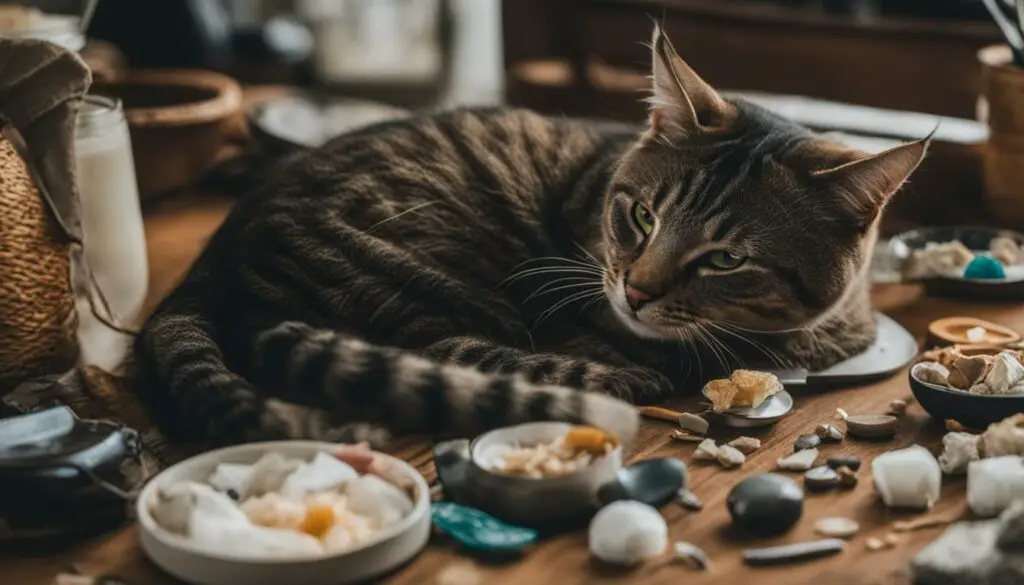
Conclusion
After spaying surgery, it is common for cats to experience some side effects and complications. Lethargy and tiredness are normal during the recovery period, which can last for about 10 to 14 days. However, if your cat continues to show signs of lethargy beyond this timeframe, it is important to consult with a veterinarian to rule out any underlying issues.
Proper aftercare is crucial to ensure a smooth and healthy recovery for your cat. This includes restricting their activity, preventing them from licking or scratching the surgical site, and monitoring for any signs of infection or inflammation. Following the postoperative guidelines provided by the veterinarian is essential in promoting optimal healing.
It is also important to note that changes in behavior, such as reduced appetite, may occur after spaying surgery. If your cat is not eating after the procedure, it is advisable to consult with a veterinarian for further evaluation.
By providing attentive care, monitoring your cat’s progress, and seeking veterinary advice when necessary, you can help ensure that your feline companion has a successful recovery from spaying surgery.
FAQ
Do cats get depressed after being spayed?
Cats do not show signs of depression after being spayed. While they may seem more distant and less affectionate, this is due to the removal of hormonal changes associated with being in heat, not depression.
Is it normal for cats to be lethargic after spay?
Yes, it is normal for cats to experience lethargy immediately after spaying surgery and for a few days thereafter. The effects of anesthesia and the healing process can cause cats to feel tired and require rest.
How long will my cat be lethargic after the spay surgery?
The recovery period for cats generally takes around 10 to 14 days, during which they may exhibit signs of tiredness as their bodies heal from the surgery. However, if the lethargy persists beyond the expected recovery period, it is advisable to seek veterinary advice.
How long does it take a female cat to recover after spay?
The recovery period for a female cat after spaying surgery is typically around 10 to 15 days. During this time, the cat may exhibit tiredness and may require extra rest and care.
What to expect immediately after the spay?
Immediately after spaying surgery, it is common for cats to feel groggy and tired due to the residual effects of anesthesia. Some cats may exhibit disorientation or reduced responsiveness. It is important to provide a calm and comfortable environment for the cat to recover and closely monitor their behavior for any signs of complication or distress.
What are the aftercare measures for cat spaying?
Aftercare measures for cat spaying include keeping the cat calm and limiting their activity, preventing them from going outside, examining the surgical site regularly for signs of infection, using a healing collar if necessary, following postoperative guidelines provided by the veterinarian, and providing attentive care and monitoring.
How to keep the spay incision from opening or getting infected?
To prevent the spay incision from opening or getting infected, it is important to prevent the cat from licking or scratching the surgical site. This can be achieved by using an Elizabethan collar or other suitable methods recommended by the veterinarian. It is also essential to avoid excessive activities that may put strain on the incision and to closely monitor the cat’s behavior and the healing process.
Are there any bathing and swimming restrictions after spaying?
It is generally advised to refrain from bathing or allowing the cat to swim until the spay incision has fully healed and the veterinarian has given clearance. This may take approximately 10 to 14 days, depending on the individual cat and the healing process. It is important to follow the veterinarian’s instructions and recommendations regarding post-spay bathing and swimming.
What is the aftercare for cat spaying?
After a cat has been spayed, specific aftercare measures should be taken to ensure optimal recovery. These measures include restricting the cat’s activity, using an Elizabethan collar if necessary, monitoring the surgical site for any signs of infection or complications, and providing attentive care and follow-up appointments as recommended by the veterinarian.
What is the recovery time after cat spaying?
The recovery time for a cat after spaying surgery is generally around 10 to 14 days. However, it is important to note that the recovery period may vary for each individual cat. Providing proper care, rest, and monitoring during this time is crucial for a successful recovery.

